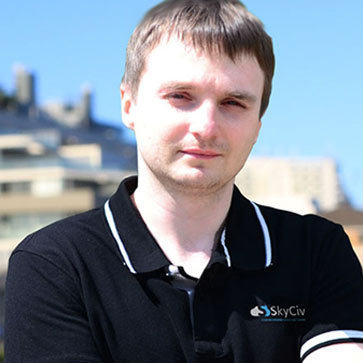API経由のSkyCIVでのFEモデルの変換と検証
今日では, FEMは、世界のさまざまな種類の構造の構造分析と設計の主なツールです. 構造の FE モデルを作成する場合、3 つの主なアプローチを区別できます。. つまり、低レベルのモデリングアプローチがあります, 高レベルのモデリング アプローチ, API経由のコマンドを介したFEモデルの生成.
低レベルのモデリングアプローチは、各モデリングステップでFEMソフトウェア機能を使用したステップバイステップモデリングに基づいています. FE モデルは手動で作成されます. エンジニアがスペース内のノードを手動で定義する, ノード間に FE を設定する, セット材料, セット荷重, 境界条件を設定する, 等. このモデリング アプローチは、エンジニアの間で広く使用されている主要なアプローチです。.
高レベルのアプローチは、FEM ソフトウェアの特別なテンプレートに基づいています, 特定のタイプの構造に適合しています. これは、エンジニアが構造データを入力するダイアログボックスである可能性があります. 次に、ソフトウェアはこのデータから既製のFEモデルを自動的に生成します. エンジニアはFEモデルの作成に時間を費やすため、このアプローチは抽象的なものと見なすことができます。.
3番目のアプローチは、構造のFEモデルを作成する上で最も強力で柔軟なアプローチの1つです。. ここで、FEモデル作成のプロセスは、特別な実行コマンドを含むスクリプトを介して実行できます。.
スクリプトベースのFEMモデルのユースケース
これは、エンジニアがFEモデルの自動生成のシーケンスを記述できることを意味します, 分析, テキスト形式を使用した結果の後処理. このようなツールは、以前の2つのアプローチと比較して、最適化を伴う構造分析の機能を提供します. 以下は、構造分析と設計のためのAPIアプリケーションの主な領域です:
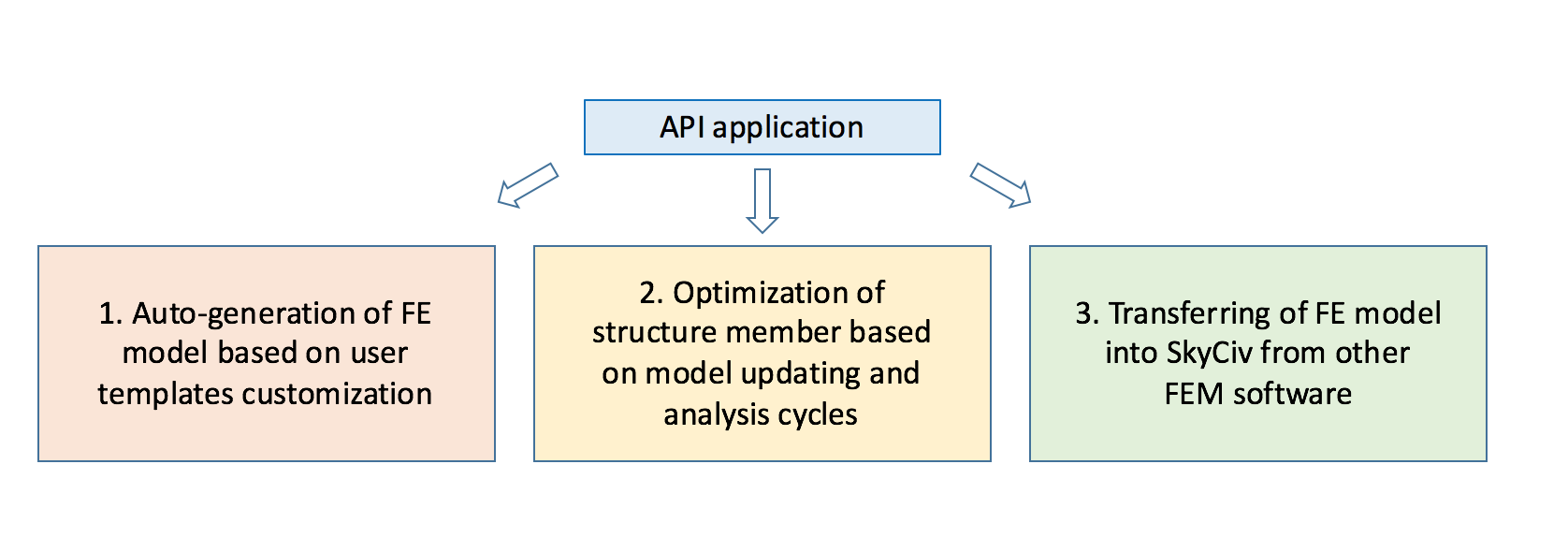 1. エンジニアは、FEモデルの自動生成用の独自のテンプレートのセットを作成できます. 例えば, エンジニアは、同じタイプの多くの異なる橋を配置する必要がある高速道路の一部を扱っています. ブリッジ構造のトポロジーは同じです, ただし、いくつかの基本的なパラメーターのみを変更する必要があります, 道幅など, スパンの長さ, メインの桁とそのサイズの数. したがって、, APIを介して, エンジニアは、多くのブリッジモデルを自動生成するためのスクリプトを作成し、それらの間に示された違いを付けて分析を実行し、その後、結果とメンバーの設計を自動後処理することができます。.
1. エンジニアは、FEモデルの自動生成用の独自のテンプレートのセットを作成できます. 例えば, エンジニアは、同じタイプの多くの異なる橋を配置する必要がある高速道路の一部を扱っています. ブリッジ構造のトポロジーは同じです, ただし、いくつかの基本的なパラメーターのみを変更する必要があります, 道幅など, スパンの長さ, メインの桁とそのサイズの数. したがって、, APIを介して, エンジニアは、多くのブリッジモデルを自動生成するためのスクリプトを作成し、それらの間に示された違いを付けて分析を実行し、その後、結果とメンバーの設計を自動後処理することができます。.
 2. メンバー設計段階, エンジニアは、反復計算を通じて必要な建設的なソリューションを自動的に選択できます. 例えば, いくつかの基準に基づいてトラス構造を最適化する必要があります, 最適たわみなど, 最適重量, 最適なトラス高さ, 要素の対角線と断面の形状. ここに, スクリプトを準備することによって, APIを介して、エンジニアはすべての可能なオプションを自動的に繰り返し作成および分析できます, 最適なもので停止します.
2. メンバー設計段階, エンジニアは、反復計算を通じて必要な建設的なソリューションを自動的に選択できます. 例えば, いくつかの基準に基づいてトラス構造を最適化する必要があります, 最適たわみなど, 最適重量, 最適なトラス高さ, 要素の対角線と断面の形状. ここに, スクリプトを準備することによって, APIを介して、エンジニアはすべての可能なオプションを自動的に繰り返し作成および分析できます, 最適なもので停止します.
 3. APIを使用するもう1つの重要な例は、転送です。 (変換) 他のソフトウェアからのSkyCIVの既製のFEモデルの. 例えば, いくつかの企業が共通のプロジェクトに取り組んでおり、さまざまなソフトウェアで構造分析を実行する必要があります. このようなニーズはいくつかの理由で発生する可能性があります, 信頼性の結果を比較する場合, または、ソフトウェアの1つでは、他のソフトウェアにある分析関数はありません. FEモデルの作成をゼロから並行して時間をかけています. 最も効果的な方法は、ソフトウェアの1つに既製のFEモデルを使用し、API経由で別のFEモデルに転送することです。.
3. APIを使用するもう1つの重要な例は、転送です。 (変換) 他のソフトウェアからのSkyCIVの既製のFEモデルの. 例えば, いくつかの企業が共通のプロジェクトに取り組んでおり、さまざまなソフトウェアで構造分析を実行する必要があります. このようなニーズはいくつかの理由で発生する可能性があります, 信頼性の結果を比較する場合, または、ソフトウェアの1つでは、他のソフトウェアにある分析関数はありません. FEモデルの作成をゼロから並行して時間をかけています. 最も効果的な方法は、ソフトウェアの1つに既製のFEモデルを使用し、API経由で別のFEモデルに転送することです。.
検証のためのAPI FEMモデルの例: 防火橋, 韓国.
記事上で, APIアプリケーションの例として, FEモデルを1つのソフトウェアからSkyCIVに転送する例については、以下に説明します. 比較分析も行います. FE モデルが考慮されている構造物の例は、ソウルにある道路橋です。, 大韓民国. 橋の名前は傍花橋, 交差します 彼は引き裂いています そして、それは組み込まれました 2000 年. 橋の構造は、5 スパンの連続スキームの形で表されます。. 中央スパンはアーチトラスの形で作られています. トラス アーチは、隣接スパンの主トラスに滑らかに流れ込みます。. これは、フロントビューから橋の形の非常に美しい輪郭を与えます. アーチスパンの長さは180mです. 隣接するスパンの長さは102mです. 終了スパンの長さは78mです. ブリッジセクションの全長は540mです. ブリッジの主な構造メンバーはスチールで作られており、箱とiセクションが含まれています.
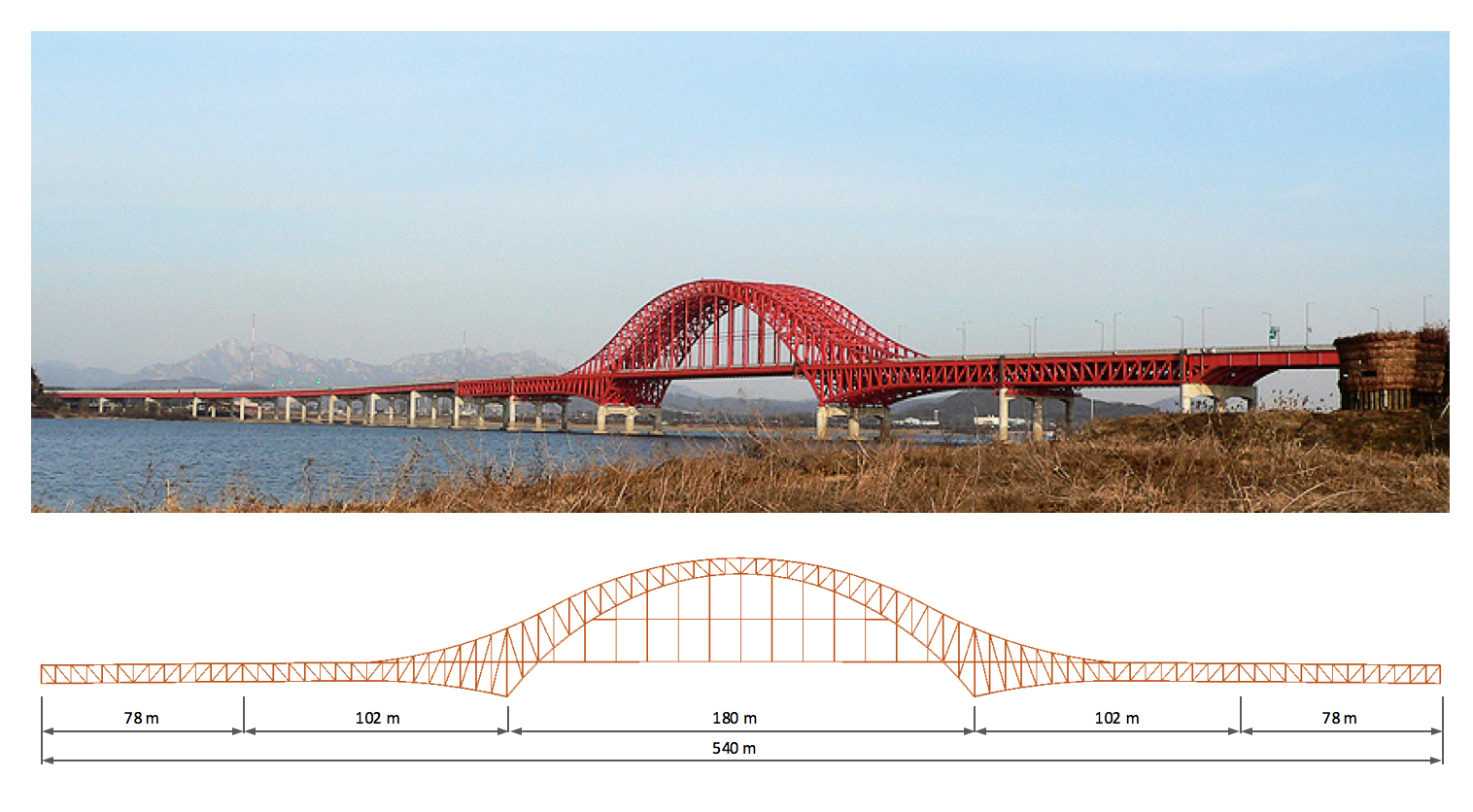
ブリッジのFEモデルは、Simulia AbaqusソフトウェアからSkyCIVに転送されます. ここに, FEモデルは、6thDofを備えた3D Tymoshenko Beam FEで完全に構成されています. すべての要素の材料には弾性係数があります 210000 MPa, 密度はです 76.98 kN / m3. すべての要素の剛性は数値で示されます. 圧縮張力下の要素の動作を説明するには, 曲げ, 断面面積などのせん断とねじれ定義された特性, 有効面積, ねじり抵抗と慣性モーメント.
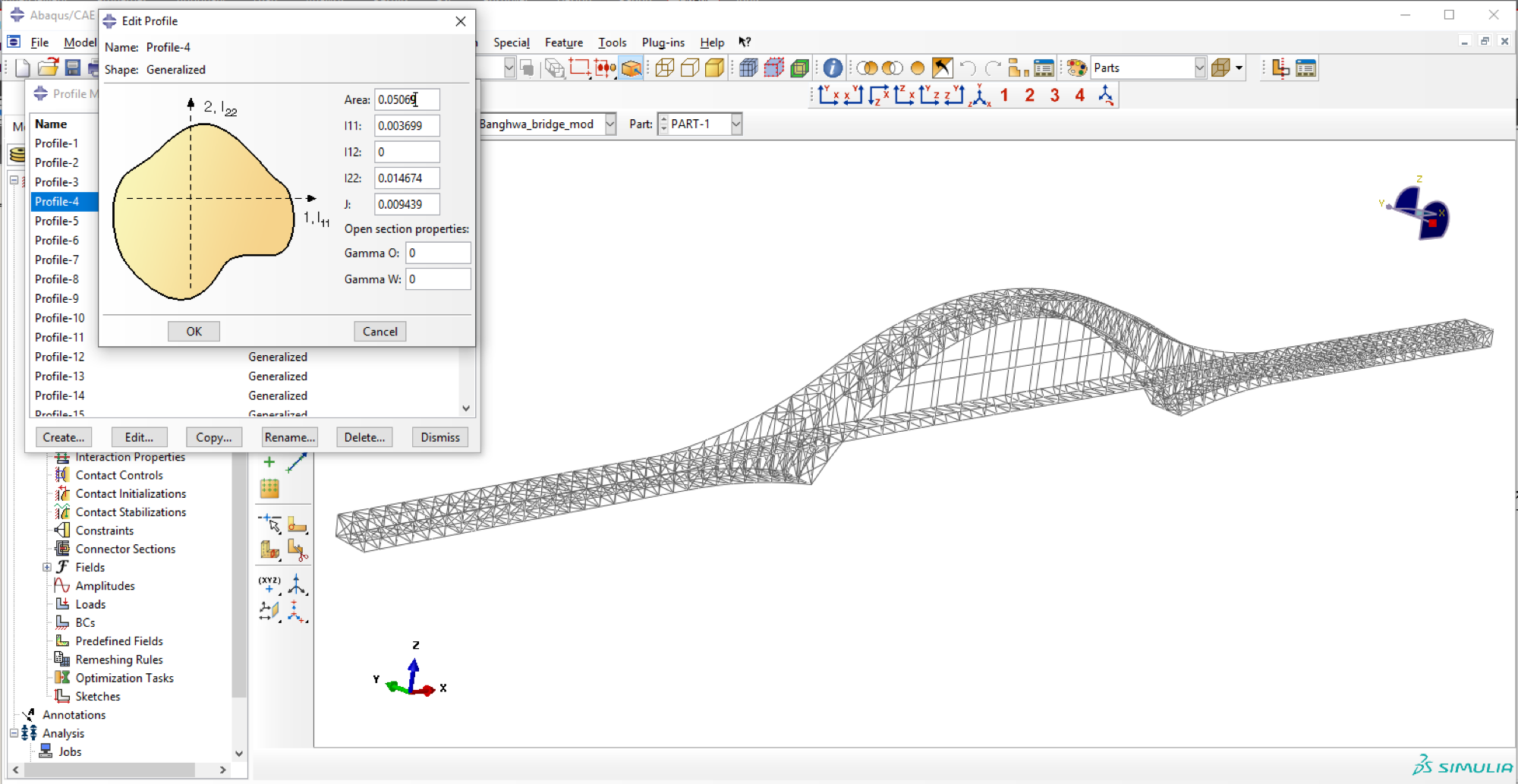
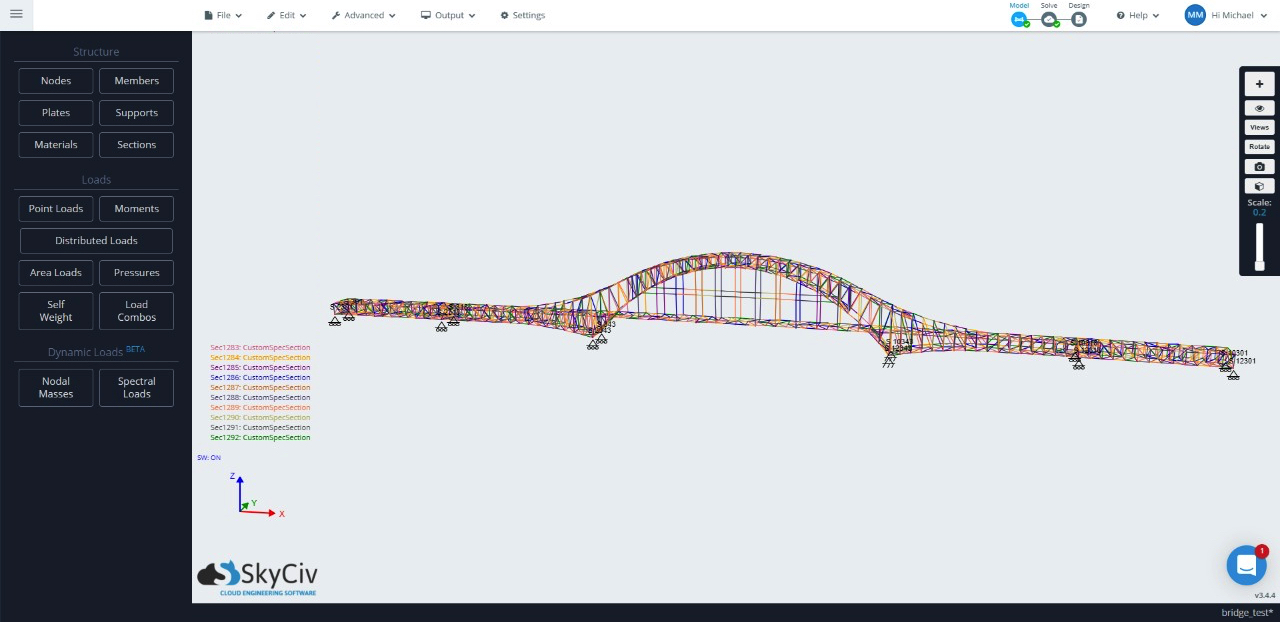
Simulia abaqusソフトウェアを使用すると、すべてのFEモデルデータをテキストファイルとして保存できます. ノードなどのデータが座標しています, FE, 材料特性, 境界条件, 等. 一連のスクリプト行として表示されます. 以下はそのような表現の例です.
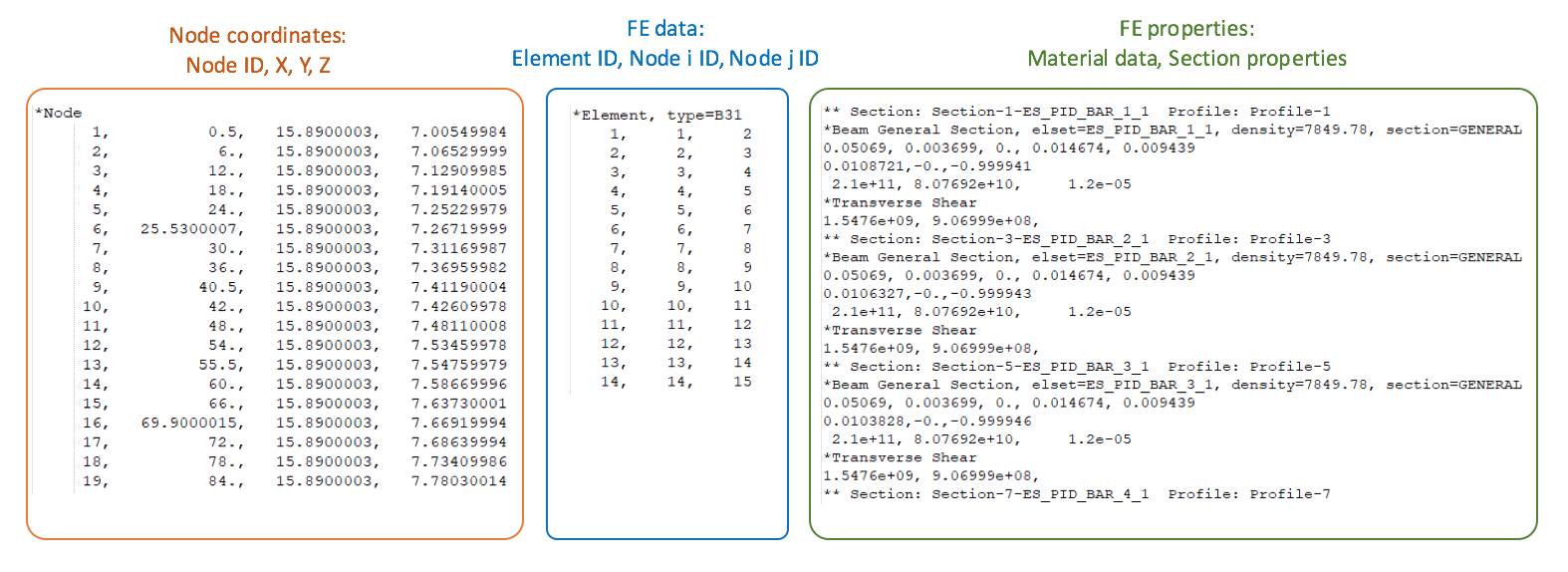
原則として, 別のソフトウェアによるデータのテキスト表現は、プログラミング言語を使用して簡単に読み取り、認識できるようにコンパイルされます。. これから, FEモデルのすべてのデータを特定して転送できることは明らかです (変換された) SkyCIVで認識されている形式に. この場合, これはJSON形式です. この形式の詳細な説明とその準備の規則は、ここで研究できます … (リンク). 以下は、変換されたJSONファイルの断片と、SkyCIVの変換されたモデルのビューです.
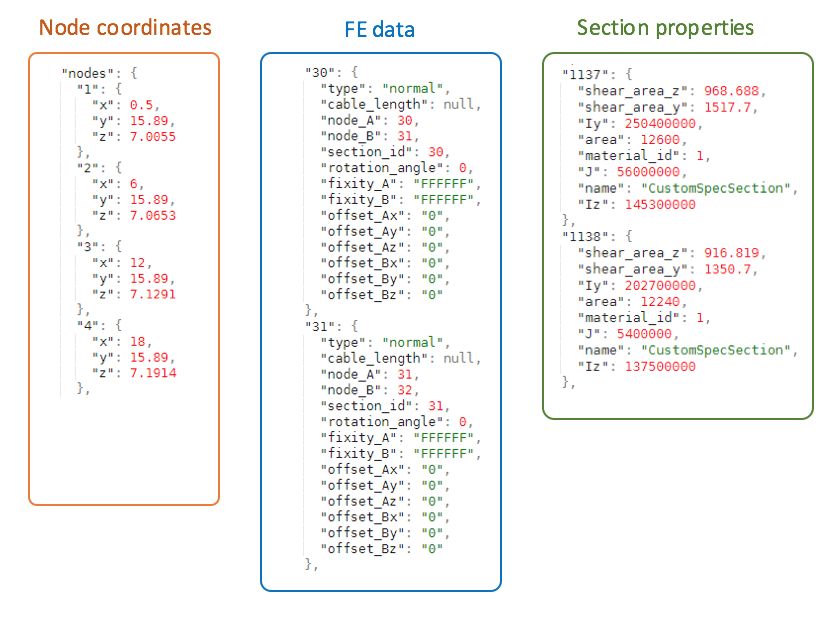
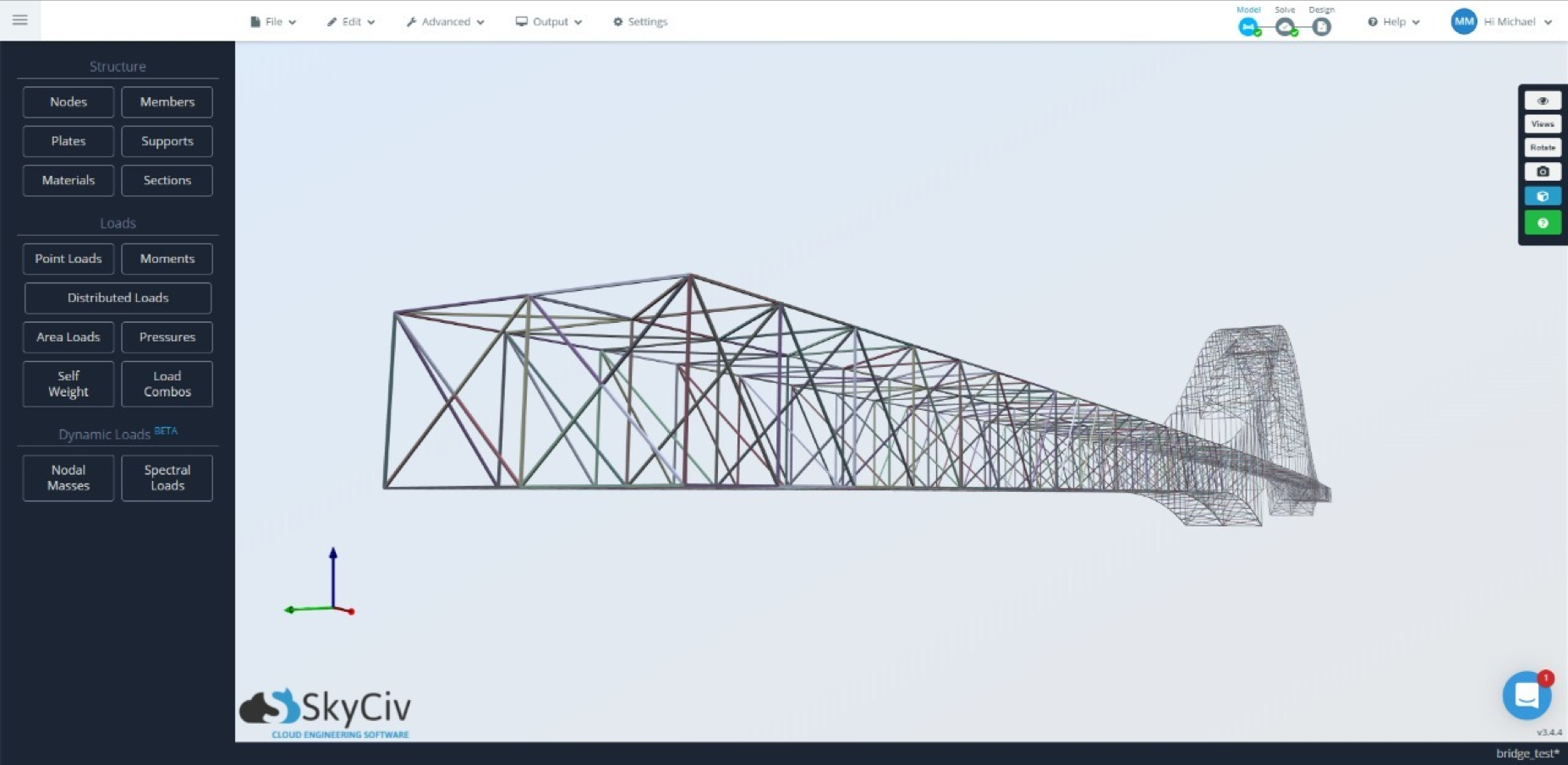
結果の検証
今, 分析の比較により、2つのソフトウェアSimulia abaqusとSkycivになります. 比較は、構造の自重のみのアクションによる静的計算から開始されます. 自重は、ソフトウェアによって分散負荷の形で自動的に適用されます, これは、要素の面積にその材料の密度を掛けることによって決定されます. 以下は、垂直のたわみの輪郭と大きさの例です. SkyCIVの最大変位はです 68.12 んん. Simulia abaqusでは、最大変位はです 67.85 んん. 見ることができるように、矛盾は取るに足らないものです, 未満 1%.
たわみ結果
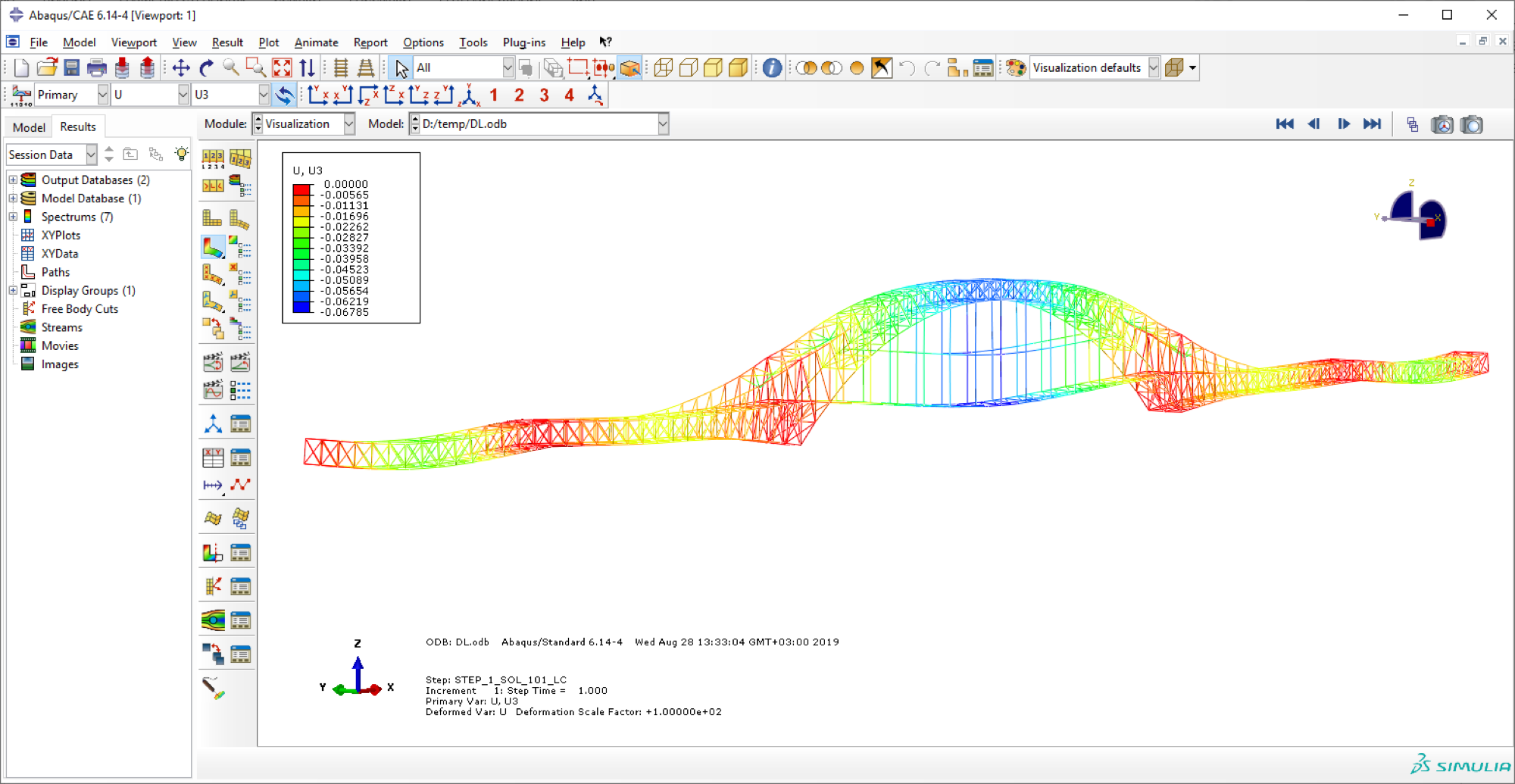
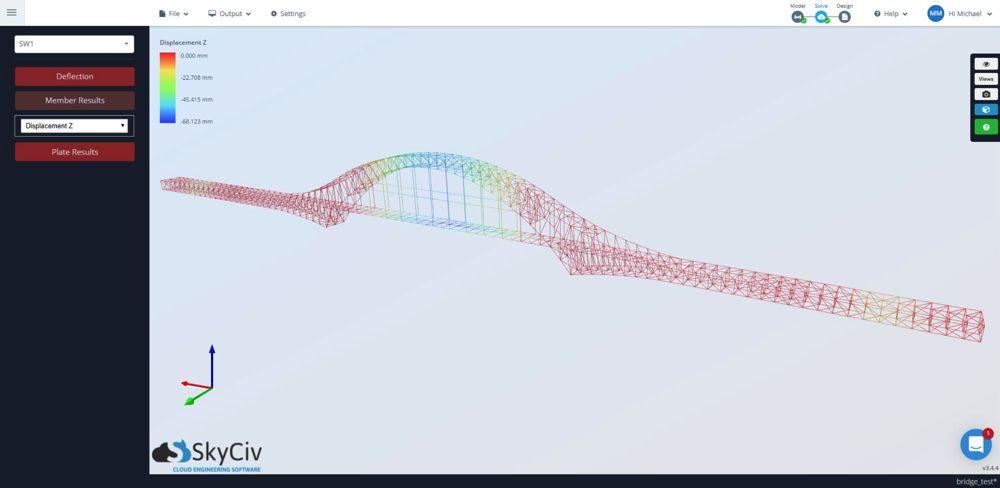
以下は、自重から変換された要素の節点質量に基づく構造の固有モードと固有値の比較です. 最初の固有モードは、橋の平面内の部材の曲げを表示します. SkyCivでは頻度は 0.991 Hz, 同時にSIMULIAAbaqusでは周波数は 0.981 Hz. 2番目の固有モードは、水平面での橋床版の横曲げによって特徴付けられます. SkyCivでは頻度は 1.77 HzおよびSIMULIAAbaqusでは、周波数は 1.72 Hz. 両方のソフトウェアの構造固有モードが同じであることがわかります. ソフトウェア間の固有値間の不一致は範囲内です 3%.
モード 8 結果
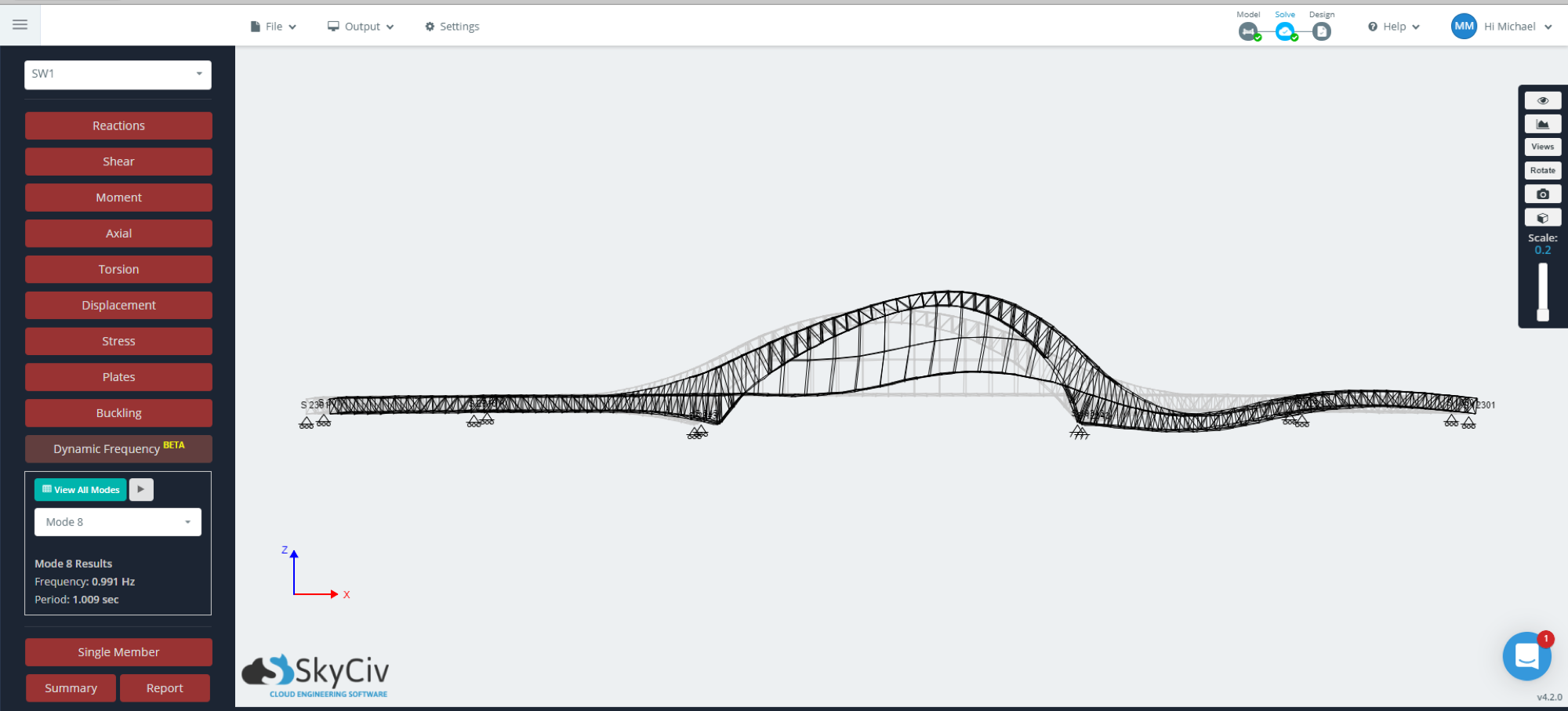
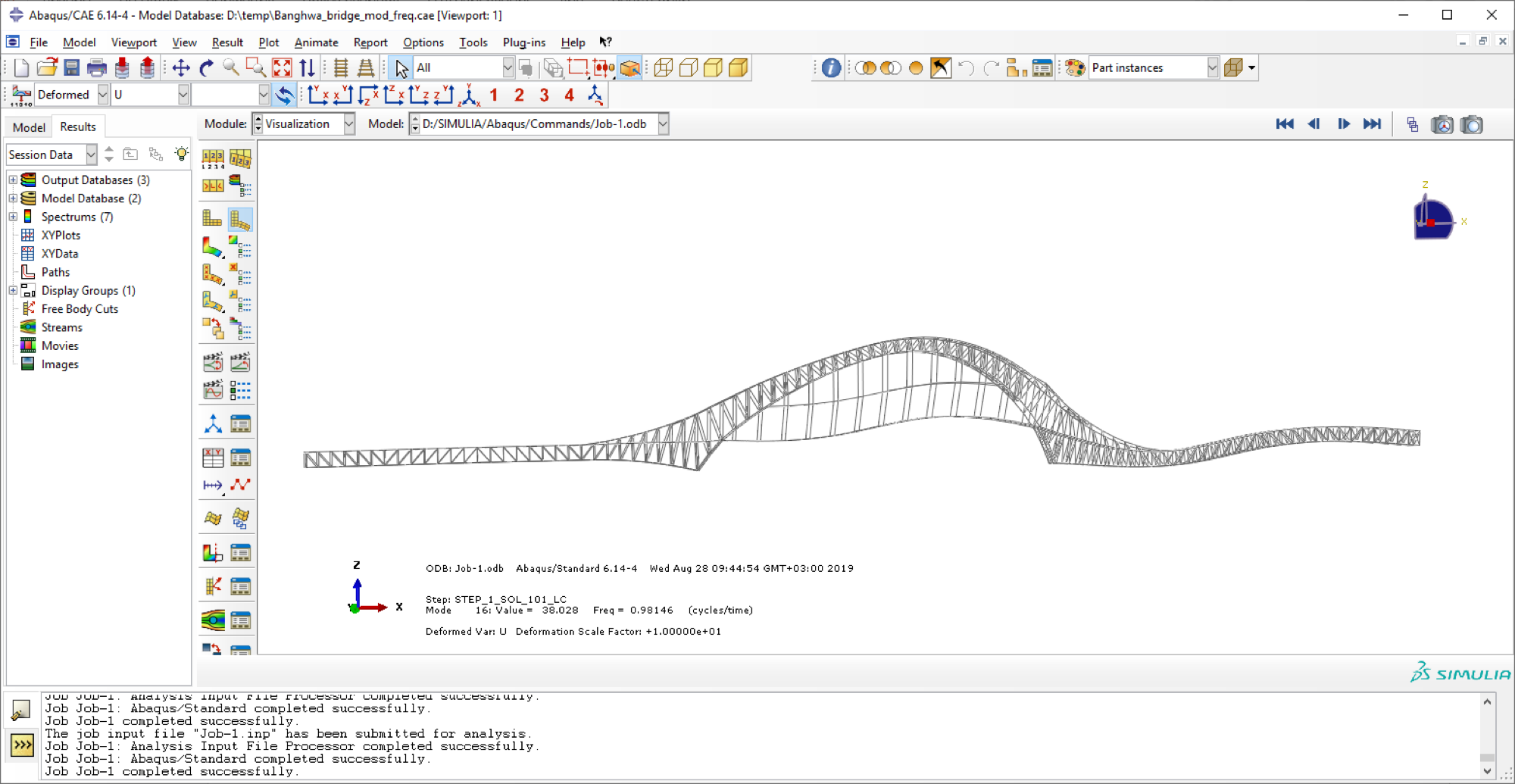
モード 16 結果
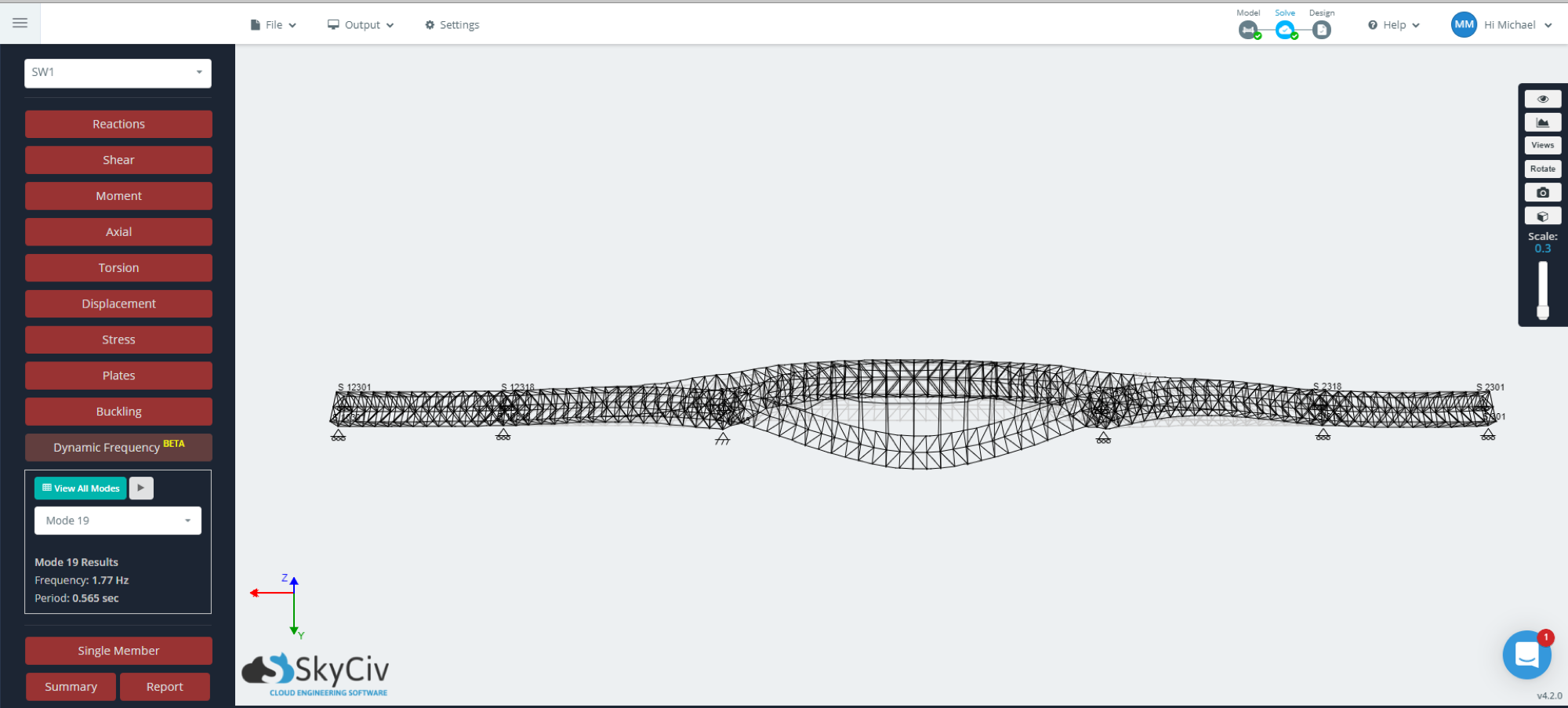
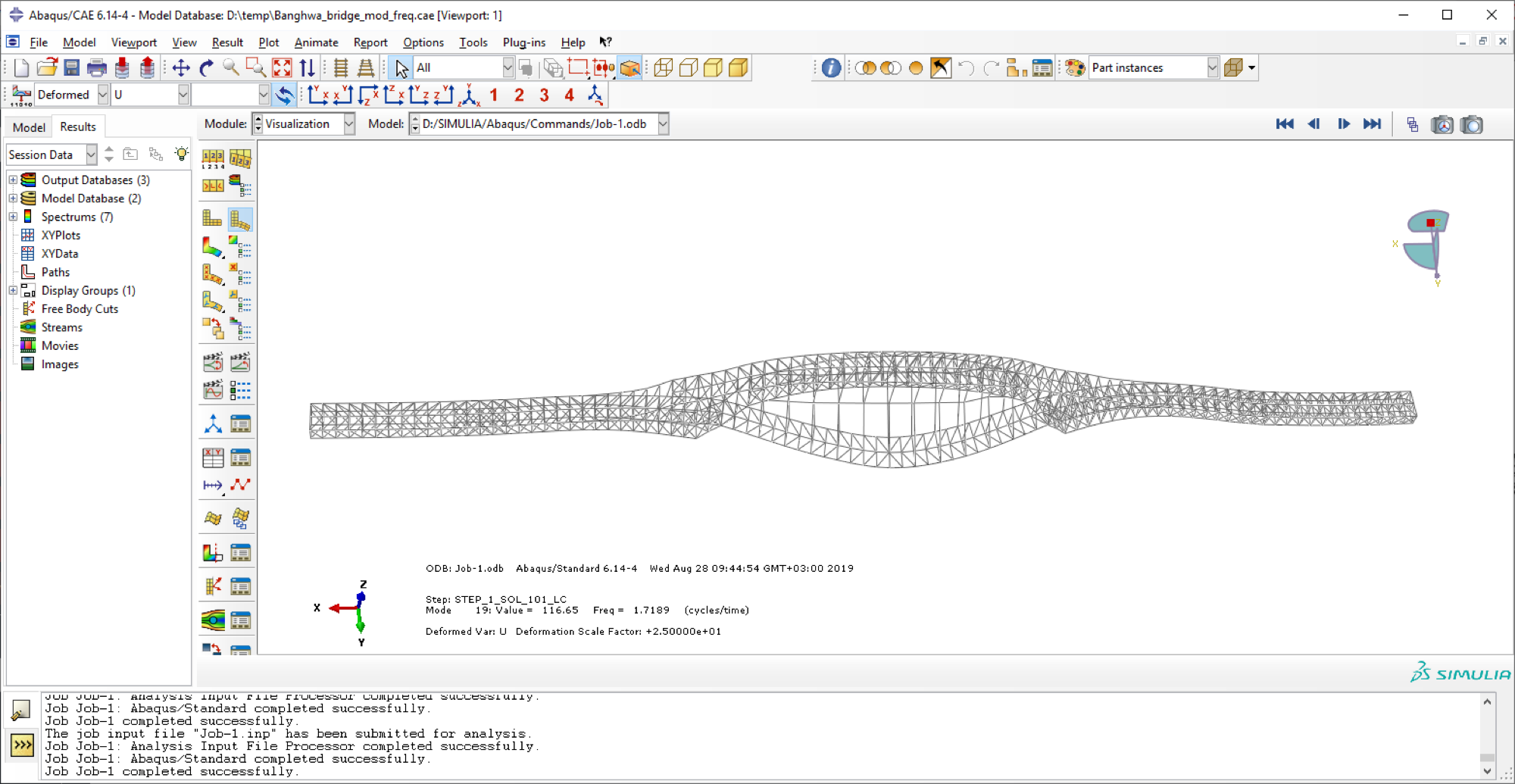
上記の資料は、APIを実際に適用するタスクの1つを効果的に解決するプロセスを示しています. スクリプトAPIを作成すると、FEモデルを作成するための広範な機会が提供されます。, SkyCivでの計算を成功させ、正確にするために、他のソフトウェアから既存のモデルを転送することを含みます. 次の資料は、SkyCivでAPIを使用する他の例を示しています.
検証結果の要約
| 結果 | SkyCiv | 第三者 | 分散 |
|---|---|---|---|
| マックス. 偏向 | 68.12 んん | 67.85 んん | 0.396% |
| モード 8 周波数 | 0.991 Hz | 0.981 Hz | 1.009% |
| モード 8 形状 | 目視検査合格 | ||
| モード 19 周波数 | 1.77 Hz | 1.72 Hz | 2.825% |
| モード 19 形状 | 目視検査合格 | ||
構造エンジニア, 製品開発
MEng (民事)
[email protected]

